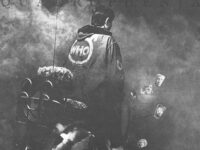In an undelivered letter “written to the gods,” Pete Townshend advised his young son on his first birthday in 1990 to “Be a pessimist. It is the safest, most pragmatic way to be. Being an optimist may enrich the lives of others … but it leads you unaware to danger.” As much as he’s failed to fully embrace the former course of action in favor of the hazards of the latter, the Who’s resident and restive “seeker” – forever, as he sang on the celebrated 1971 track embedded above, “focusing on nowhere, investigating miles” – is seemingly bent on underpinning even his seemingly impulsive actions to a purposeful or philosophical aim “to find the key to fifty million fables.”
That kind of aspiration even (surprisingly) extends to, as we discover in the first pages of Townshend’s enlightening and enlivening autobiography Who I Am, his iconic guitar smashing. Or as Townshend recalls his inaugural split-second impulse in a 1964 West London show when he “stumbled upon something more powerful than words, far more emotive than my white boy attempts to play the blues”: “I haven’t smashed it: I’ve sculpted it…” In a later chapter, however – the same chapter that describes how a toss of a coin decided which universally acknowledged guitar obliterator, Pete or Jimi Hendrix, would perform first at the 1967 Monterey Pop Festival – the action is not so much a case of instrumental upheaval for the sake of upheaval. Townshend here elucidates his concept of “destruction is art when set to music” as based on the ideas of auto-destructive artist Gustav Metzger.
There’s a methodology to the seeming madness surrounding Pete Townshend that comes out in this warts-and-all memoir, rife with insights and asides. The mercurial rock legend, though not always admittedly consistent in his thoughts as they relate to his deeds – and intensely human for these complexities – takes brutally candid and confessional pains in chronicling his personal life, including his early years with a dysfunctional family and abusive grandmother, and tying them into his artistic and spiritual goals. Indeed, Townshend expressly aligns himself with spiritual seekers as opposed to political activists, although as is well documented throughout Who I Am, it’s not always at the expense of the sex and drugs concomitant with rock and roll, including extramarital flings and alcohol.
With the Who’s fourth album, 1969’s Tommy, one of the first rock operas – as a “Ray Davies devotee” Townshend is careful to similarly cite (among others) the Kinks’ British music hall-styled Arthur from the same year – was an ambitious album of spiritual longing not wholly out of line with the teachings of Meher Baba, the Indian “Compassionate Father” whose views “fitted in with my views of the cosmos.” “I had never intended for Tommy to be a proselytizing vehicle for Meher Baba,” says Townshend, “but it was certainly intended to reflect spiritual yearning during these post-psychedelic times.”
A more down-to-earth concern is set as the foundation for 1973’s Quadrophenia, which (in the wake of the largely unrealized rock opera project, Lifehouse) came after the stellar Who’s Next, the powerhouse Live at Leeds, and a captivating performance at Woodstock. Another double-album, this audacious coming-of-age song-cycle is rooted in the Who’s mid-’60s Mod beginnings, while representing, Townshend notes, the most creative and demanding work of his career. As a complex story of a confused Mod named Jimmy combined with an exploration of a four-way split personality, it’s also his most intricate and multi-faced work intent on to revealing the four contrasting members of the Who themselves.
“Roger was the helpless dancer;” Townshend explains, “John, the romantic; Keith, the bloody lunatic; and I, needless to say, was the beggar/hypocrite. But,” he continues, “the four aspects of Jimmy the Mod’s multiple personality were, in a sense, all to be found in me…”
Who I Am goes on to trace the subsequent mixed-bag of Who releases from 1975’s The Who By Numbers to 2006’s well-received Endless Wire, the first Who studio album since It’s Hard in 1982, by which time Pete Townshend, feeling the group had lost touch with their fan base, states that “our ability to reinvent ourselves was declining as we continued a long, slow descent.” This brick of a book also picks up on Townshend’s continuing solo work (after 1972’s Who Came First) in albums like Empty Glass (1980), All the Best Cowboys Have Chinese Eyes (1982), White City: A Novel (1985), and Psychoderelict (1993).
Interspersed throughout are discussions of this self-proclaimed workaholic’s other elaborate projects, such as The Iron Man: A Musical in 1989, an adaptation of British poet Ted Hughes children’s fable, and various benefit and charity recordings and performances. These would unfortunately include shows, whether solo or in the slew of Who reunion tours, undertaken for the benefit of the other members of the Who as they, along with Townshend’s own declining hearing and later an injured wrist, faced health and financial difficulties.
After Keith’s 1978 sedative overdose at the age of 31, Townshend rather snarkily but understandably declares about a press conference announcing a new record and tour that in addition to keeping mum about doing it for the money, “None of us offered that I hadn’t really wanted to go deaf in order to save Roger and John from being forced to live in smaller houses.”
A clearer and more incisive picture of group dynamics can be seen in the many scenarios depicting the clashing wills and incidents of disharmony, many of which arose in resistance to Pete Townshend’s grandiose ideas and rock opera concepts, but which in more immediately crucial but less frequent ways, was anchored in musical considerations. Of particular fascination is the 1981 group meeting in which, among other issues, Roger Daltrey tells Kenney Jones, Moon’s replacement, that he can’t stand to work with him anymore in part, Townshend discovers, because Roger used to literally dance to the frenetic Keith’s drums but found it difficult to do so with Jones, who simply “kept the beat without decorating it.”
On the other hand, the anchoring, accomplished bass player John Entwhistle, by finding “more space in the Who’s new sound,” reveled in the new opportunities afforded by the choice of Jones as drummer. The upshot for Townshend?: “Below the surface things with the Who had taken a troubling turn, and I had no idea how to set them right. Kenney stayed, but the joy I had taken in the new Who had all but evaporated.”
In addition, Townshend faces further changes in the Who’s evolution: The 2002 death, at the age of 57 in Las Vegas’ Hard Rock Hotel, of John Entwistle, with whom he goes back the furthest – as a school pal in the late ‘50s and fellow member of Daltrey’s group the Detours in 1962 – hits especially hard. “John has gone,” we wrote in his diary. “I truly loved him so much. He was the best, oldest, most supportive friend I had. He is utterly irreplaceable.”
With both Keith and John gone, things took a turn for the better with Pete’s periodically contentious relationship with Roger, but it took an unfortunate turn of events to spur things in that direction: the well-publicized but groundless accusations of child pornography that were charged in 1993 when, in the course of doing online research partly impelled by his childhood experiences, he attempted to show that the industry of child sex spans from Russian orphanages to British banks. Police confiscated Pete Townshend’s computers and files, and found nothing incriminating, but it was Roger who most vehemently came to Pete’s defense. Roger’s “solidarity with me, his faith in me and his rage at the injustice against me is something I will never forget,” says Townshend.
The vivid sense of place and time Townshend conveys in the you-are-there immediacy of Who I Am could take up another book in itself, chronicling 50 years of music history and cultural change, embellished with an amazing array of personal encounters. Townshend describes with honesty and eagerness – as if it was yesterday – crossing paths or sharing the stage with the likes of Paul McCartney, George Harrison, Eric Clapton (intervening during times of drug crisis and drawn into the lovelorn Pattie “Layla” Harrison intercessions), David Bowie, Johnny Rotten (getting drunk with him and talking about playing the lead in the film Quadrophenia), Ray Davies, Keith Richards (the inspiration for Pete’s “windmill” guitar motion), Mick Jagger (the stimulus for some serious lust), Bruce Springsteen, and many, many more.
At over 500 pages, Who I Am is the size of a paving stab and weighs just as much. You can get lost in it and care little if you find your way back out. Structured chronologically, this is a life filled to the brim but, defying pure and easy telling, it necessarily holds a few nooks and crannies of flashbacks, flash-forwards, and incidentals – but not intrusively so. And the many avenues, aspects, and facets to Townshend’s life and legacy (including childhood, education, family life, loving father, children, divorce, spirituality, rehab, therapy, romantic dalliances) are masterfully explored and explicated, accomplished with candor, accessibility, and wit.
Pete Townshend may not “get to get what I’m after, till the day I die,” and perhaps he feels that he can’t explain, but Townshend does a remarkably fine job with Who I Am in revealing just who he is.
Pete Townshend: Who I Am
ISBN: 978-0-00-746603-0
Format: Hardback
Imprint: HarperCollins
- Almost Hits: The Kinks, “Waterloo Sunset” (1967) - February 26, 2013
- Books: Rock ‘n’ Roll Billboards of the Sunset Strip, by Robert Landau (2013) - February 16, 2013
- Pete Townshend, ‘Who I Am: A Memoir’: Books - November 6, 2012




